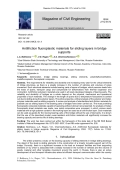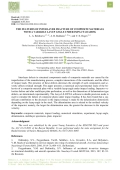The requirements for reliability and durability are increasing every year for the critical elements of bridge structures, as there is a steady increase in the number of vehicles and volumes of cargo movement. Such structural elements include bearing parts of spans of bridges, which perceive loads from the mass of spans, transport cargo and compensate for deformations from thermal expansion and contraction. Antifriction polymeric materials are used in all newly developed designs of bearing parts. The reliability and durability of bridges as a whole depend on the physical, mechanical and operational properties of such materials. The change in the length of spans due to temperature fluctuations is carried out due to sliding along the polymer layers. The article presents a critical analysis of the polymer and metal-polymer materials used as sliding supports. A review and analysis of standardized anti-friction materials for possible use as sliding layers in the bearing parts of bridges have been carried out. The most promising fluoroplastic composite materials capable of operating without lubricant are presented. An analysis of metal-fluoroplastic sheet materials was made, new metal composites were proposed, in which various mesh materials with a high polymer content in the working layer are used as an anti-friction layer. Such materials can be used as guides for the moving bearing parts of the bridge without the use of lubricants. It is shown that the use of the described modern wear-resistant anti-friction materials will significantly increase the bearing capacity and service life of sliding bearings.
Наличие в элементах конструкций из композиционных материалов межслойных дефектов, связанных с несовершенством технологии их изготовления, сложными взаимодействиями компонентов, воздействием ударных нагрузок, приводит к снижению прочности та-ких элементов и оказывает серьезное влияние на остаточную прочность. В работе проведено численно-экспериментальное исследование поведения при ударном нагружении пластины из композиционного материала с переменным углом укладки слоев. Экспериментально определены скорости ударника до и после пробития многослойной пластины, а также размеры межслойных дефектов в виде расслоений. Для моделирования процесса разрушения пластин из композиционных материалов при ударном нагружении использовали программное обеспечение Ansys LS-DYNA в режиме двойной точности. Выявлено, что значительную роль в снижении энергии удара играют размеры расслоений в зависимости от угла укладки слоев в пакете. Получена зависимость между площадью расслоения и остаточной скоростью ударника: чем больше площадь дефекта типа «расслоение», тем больше снижение скорости ударника.

